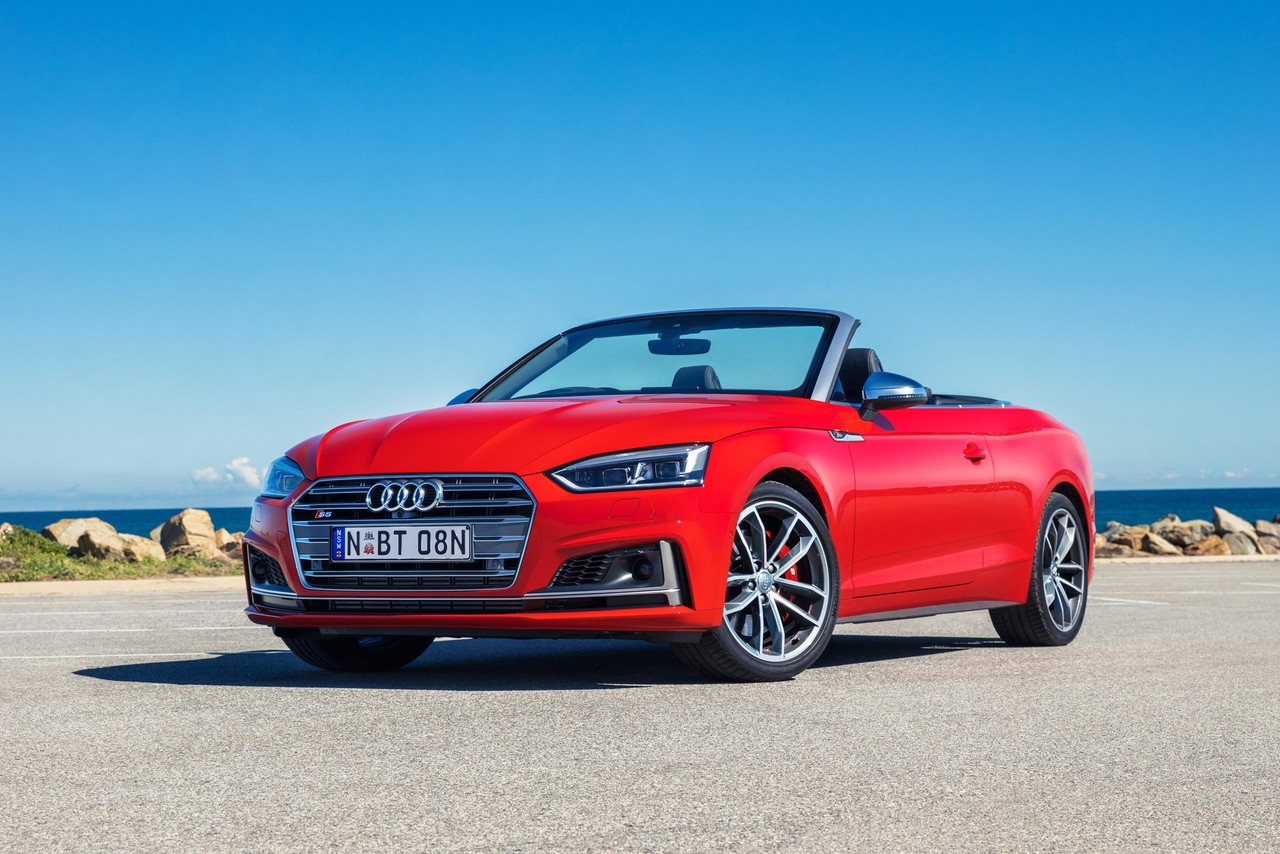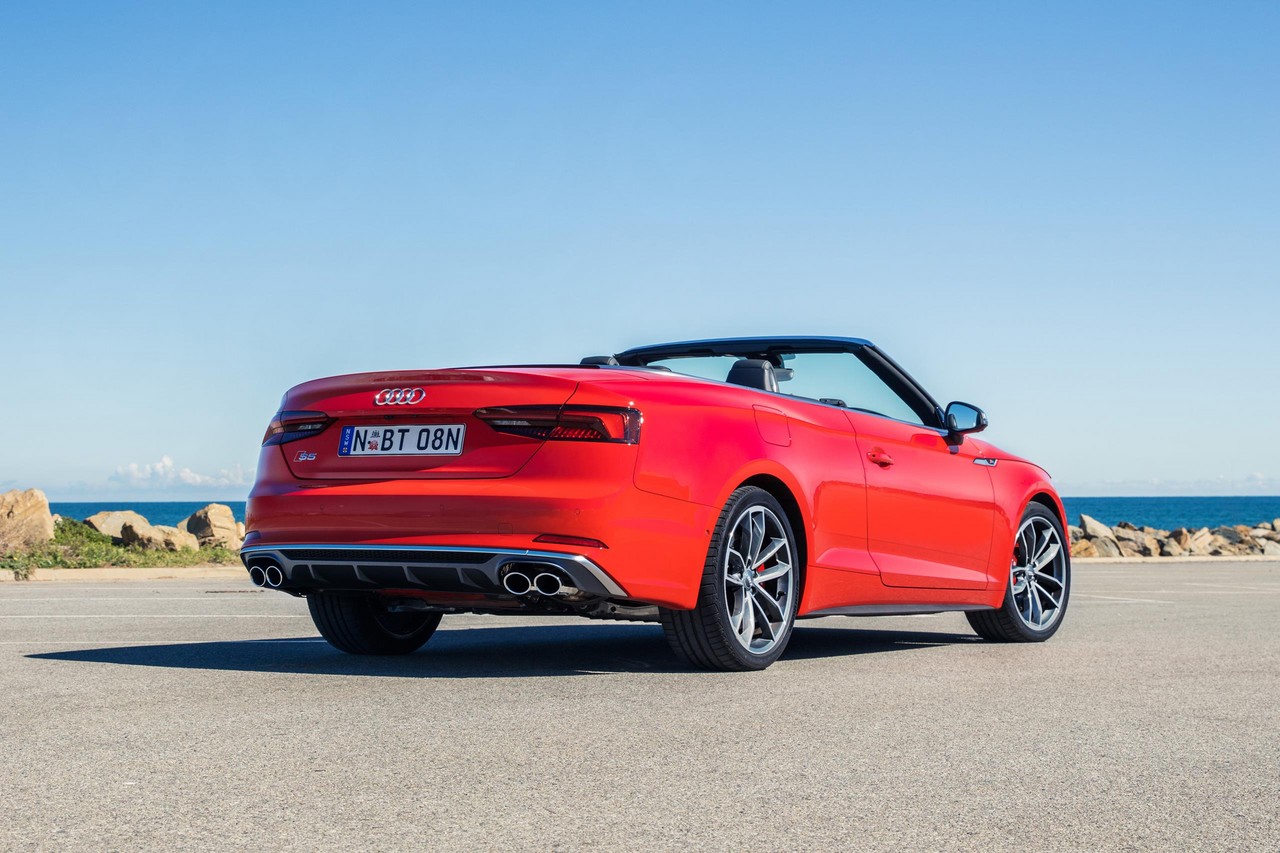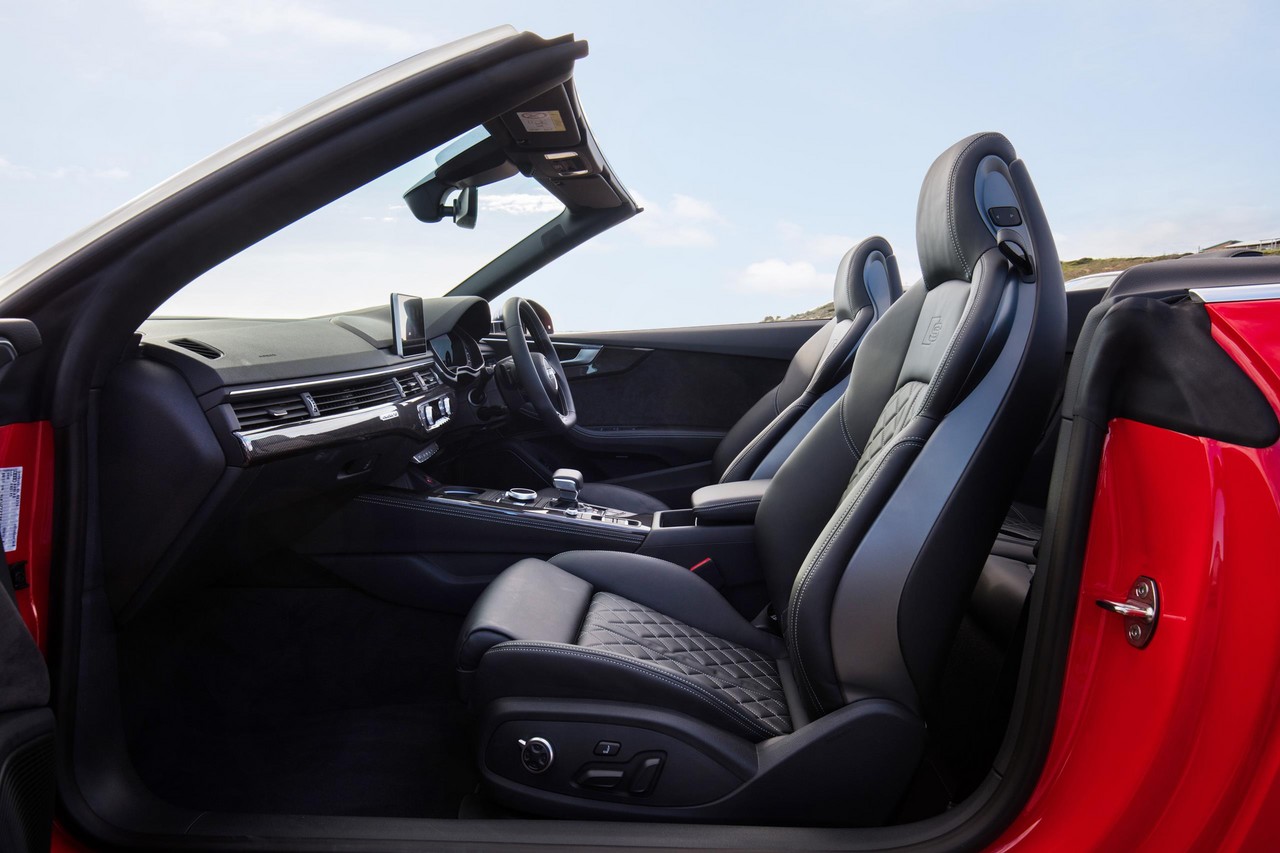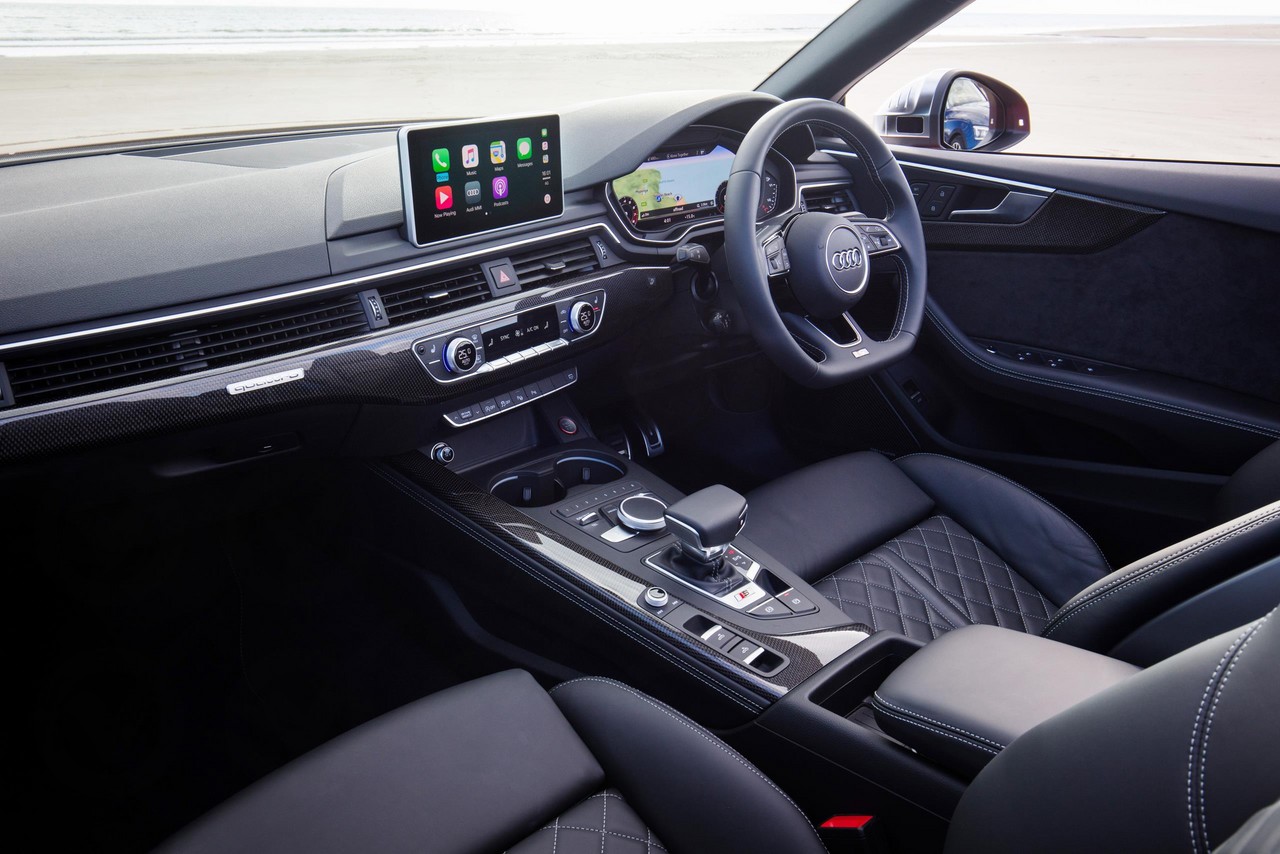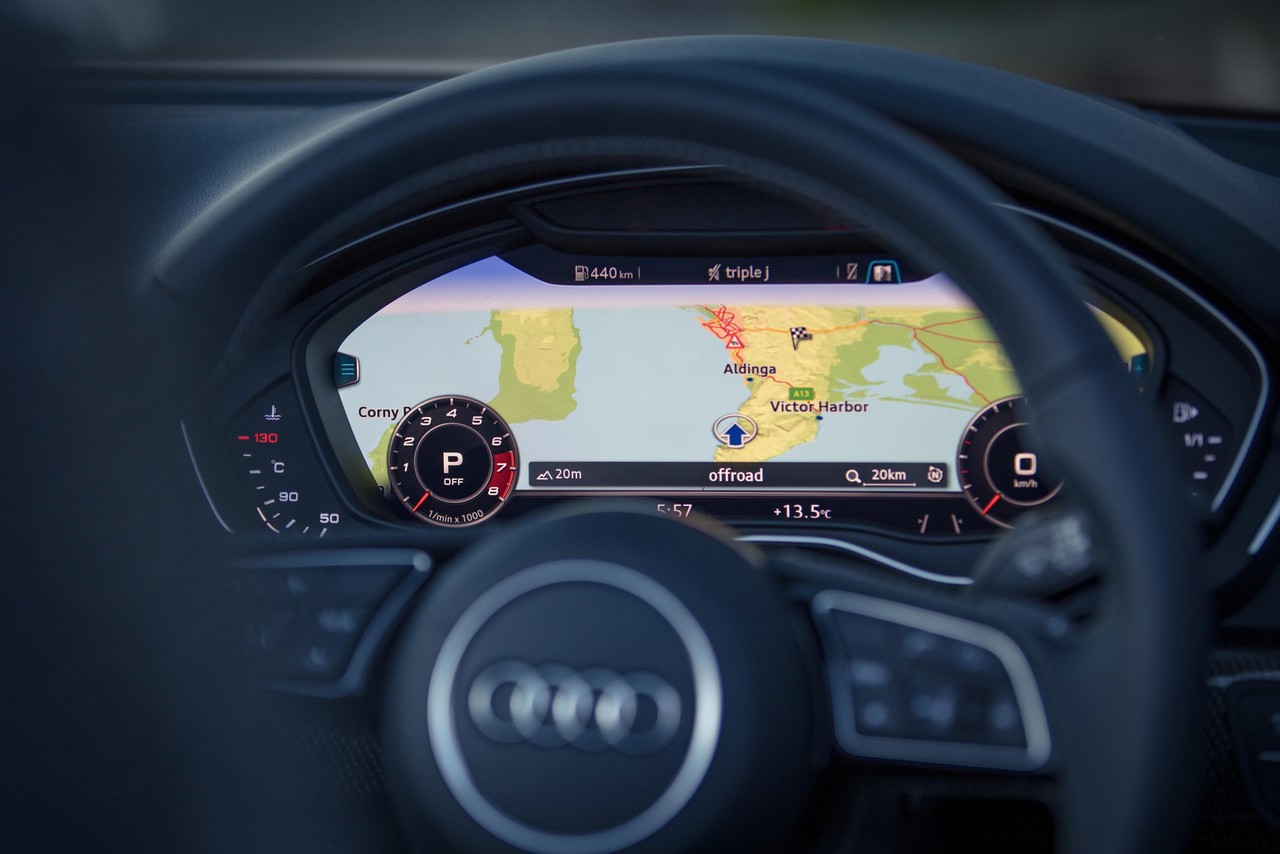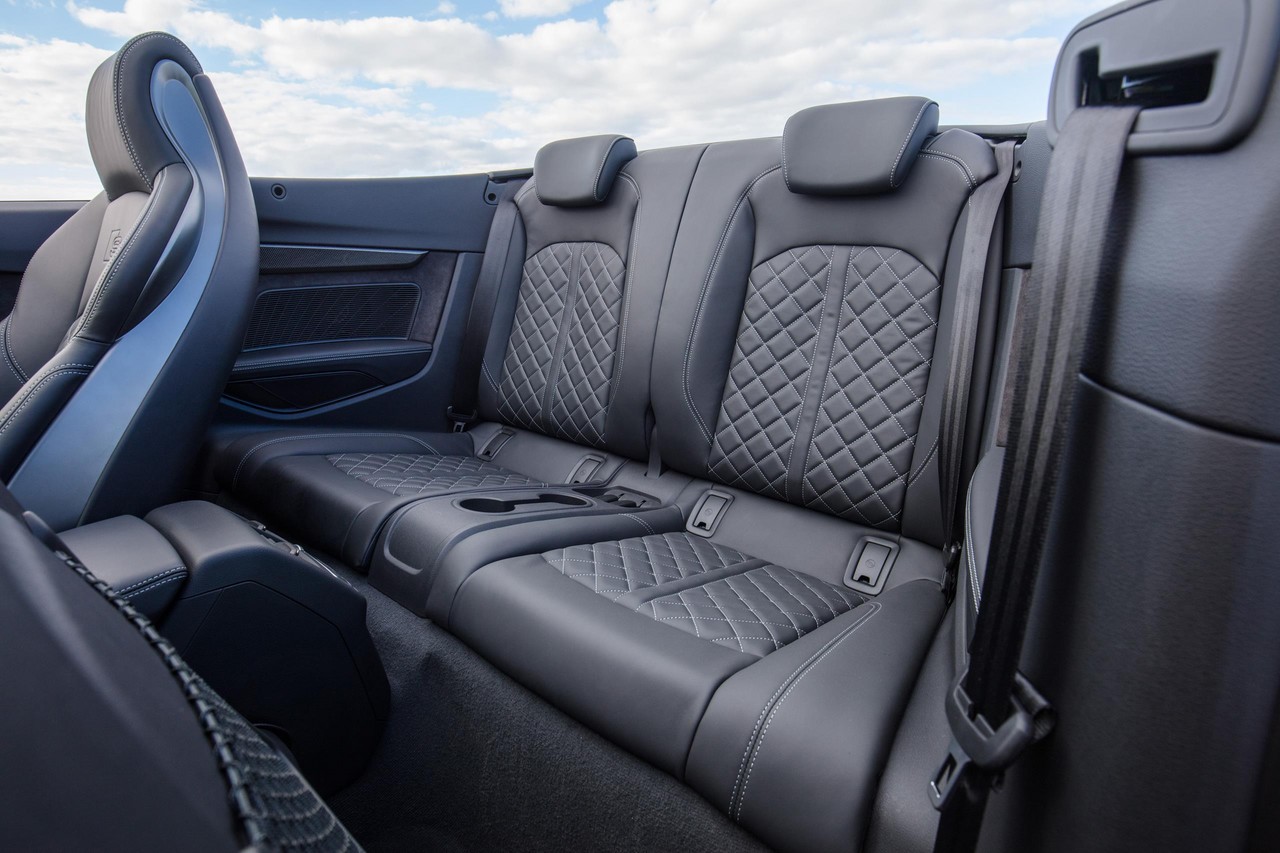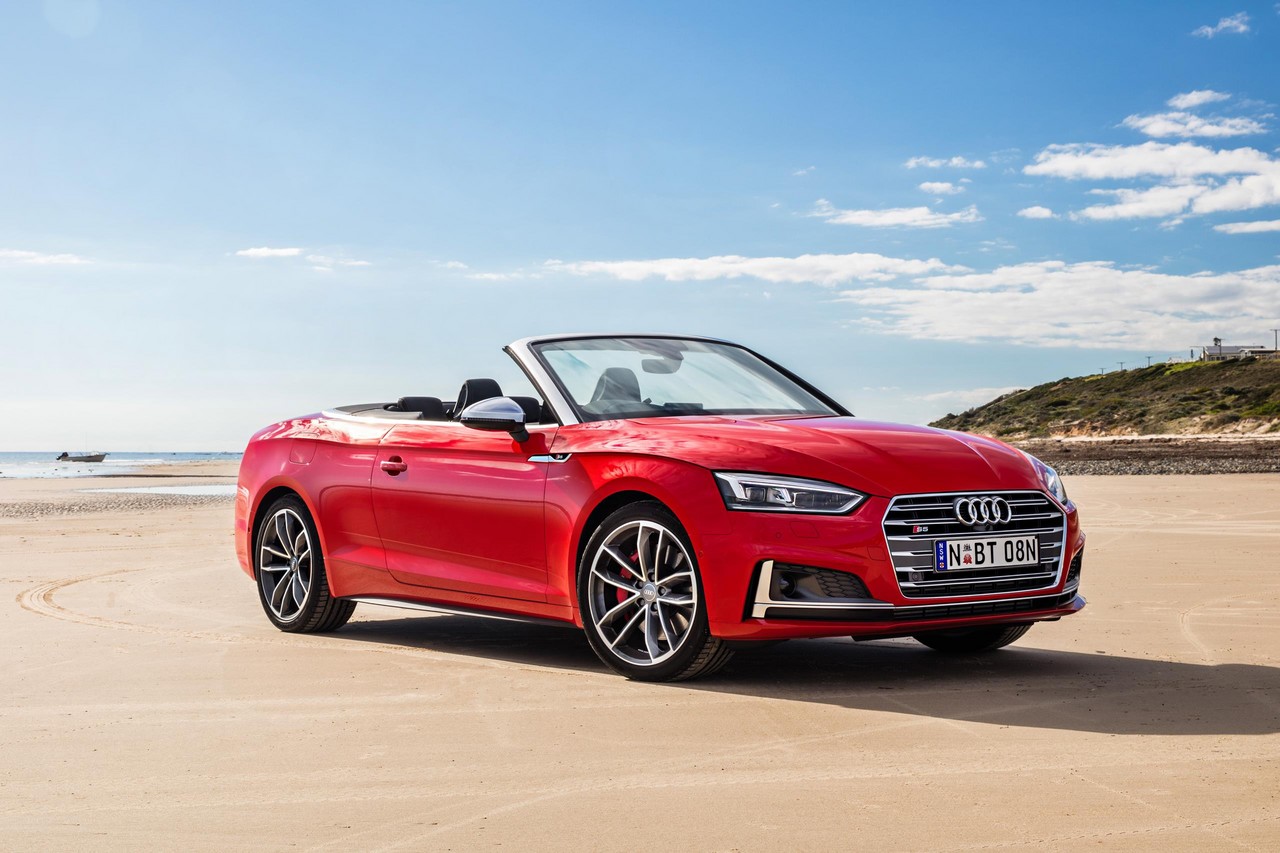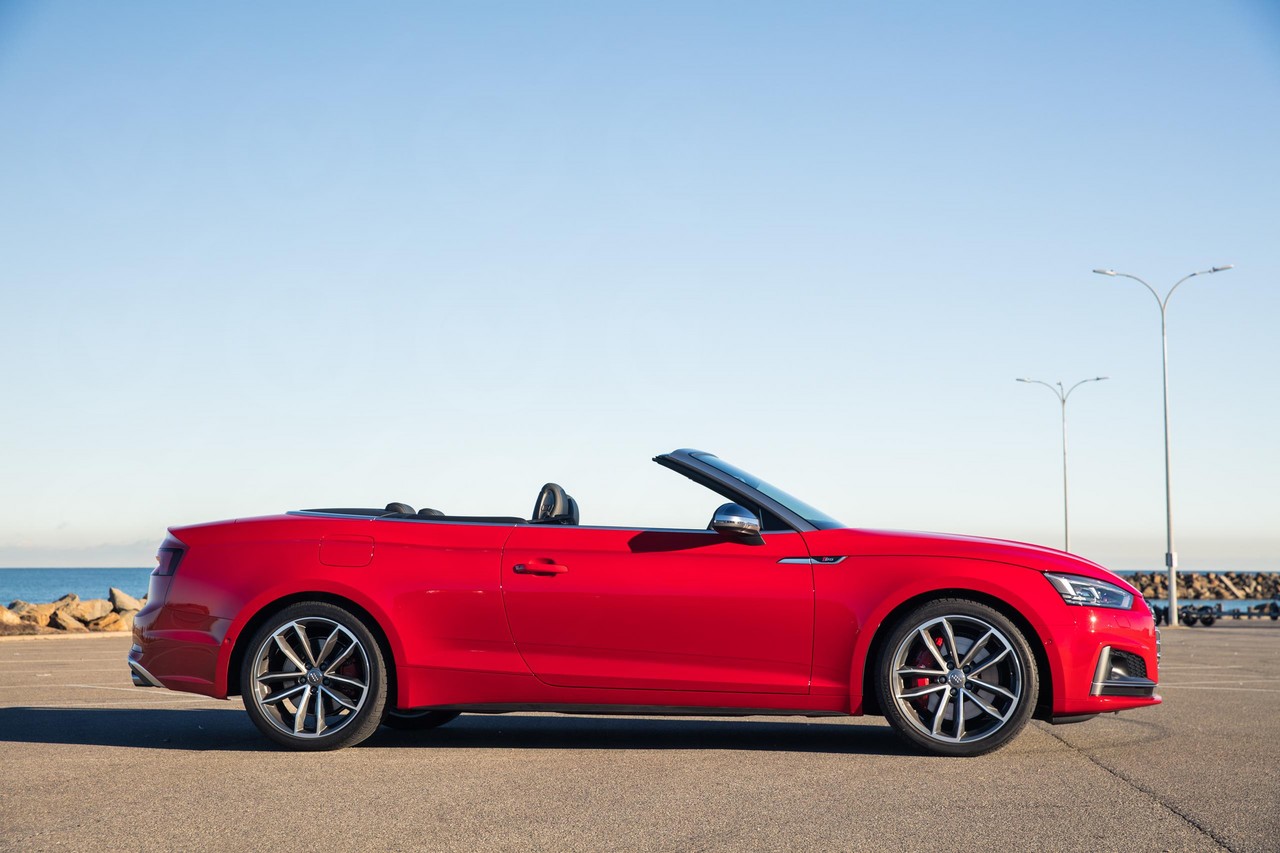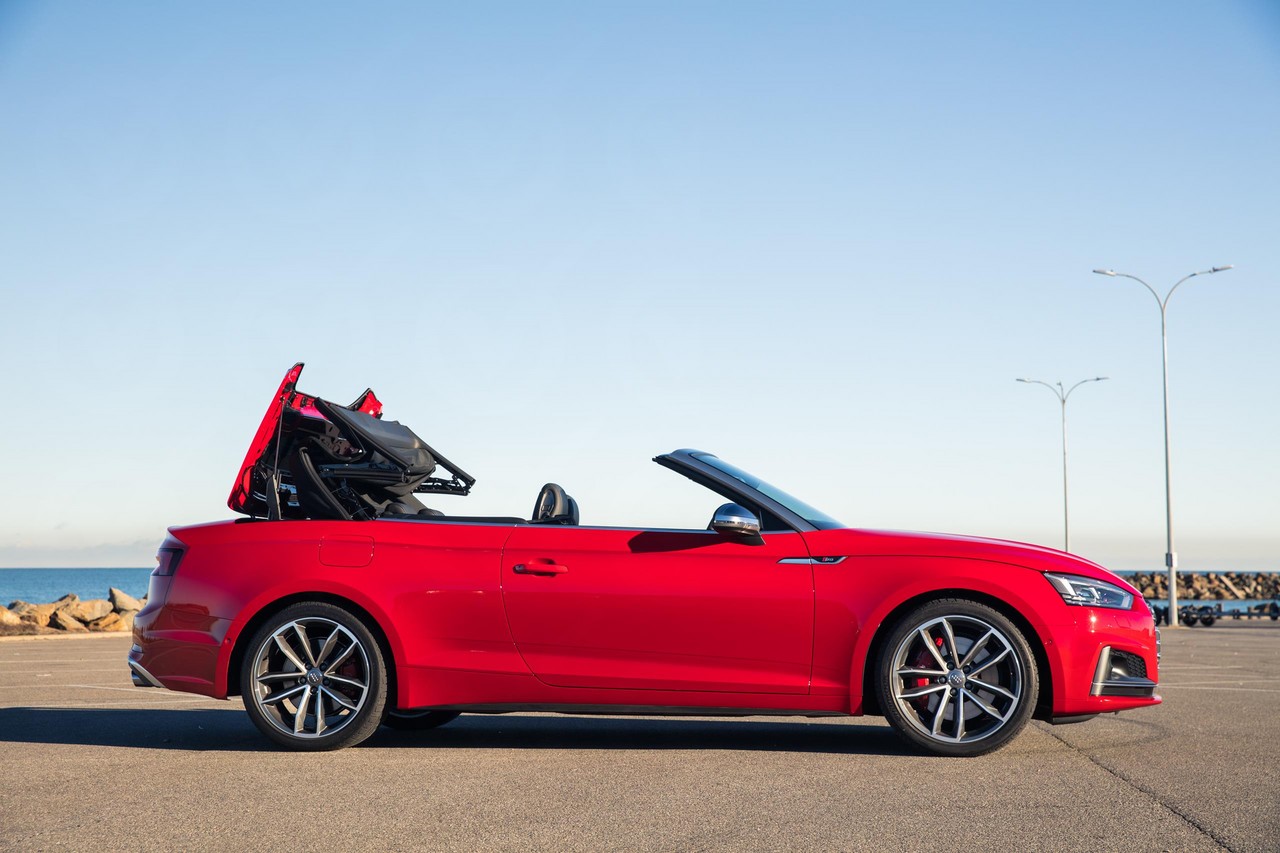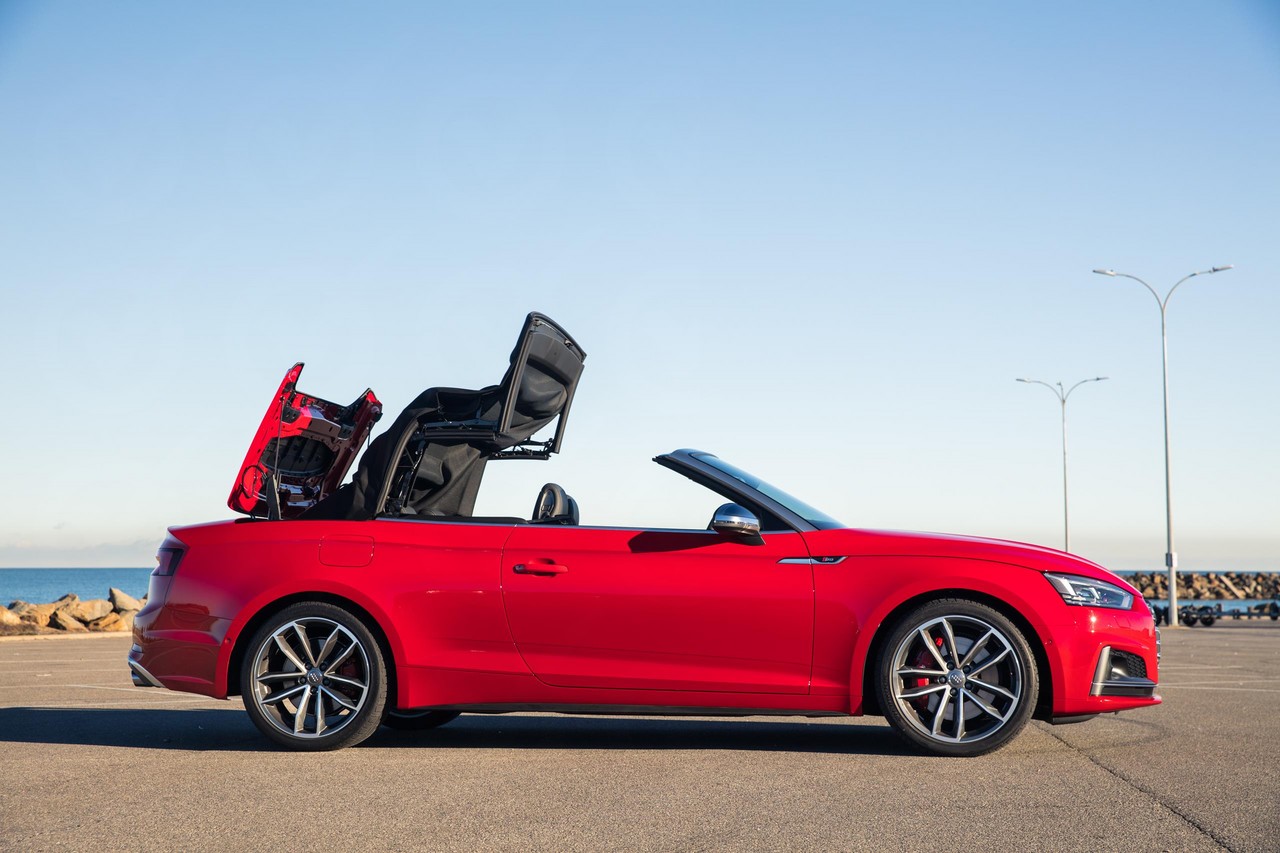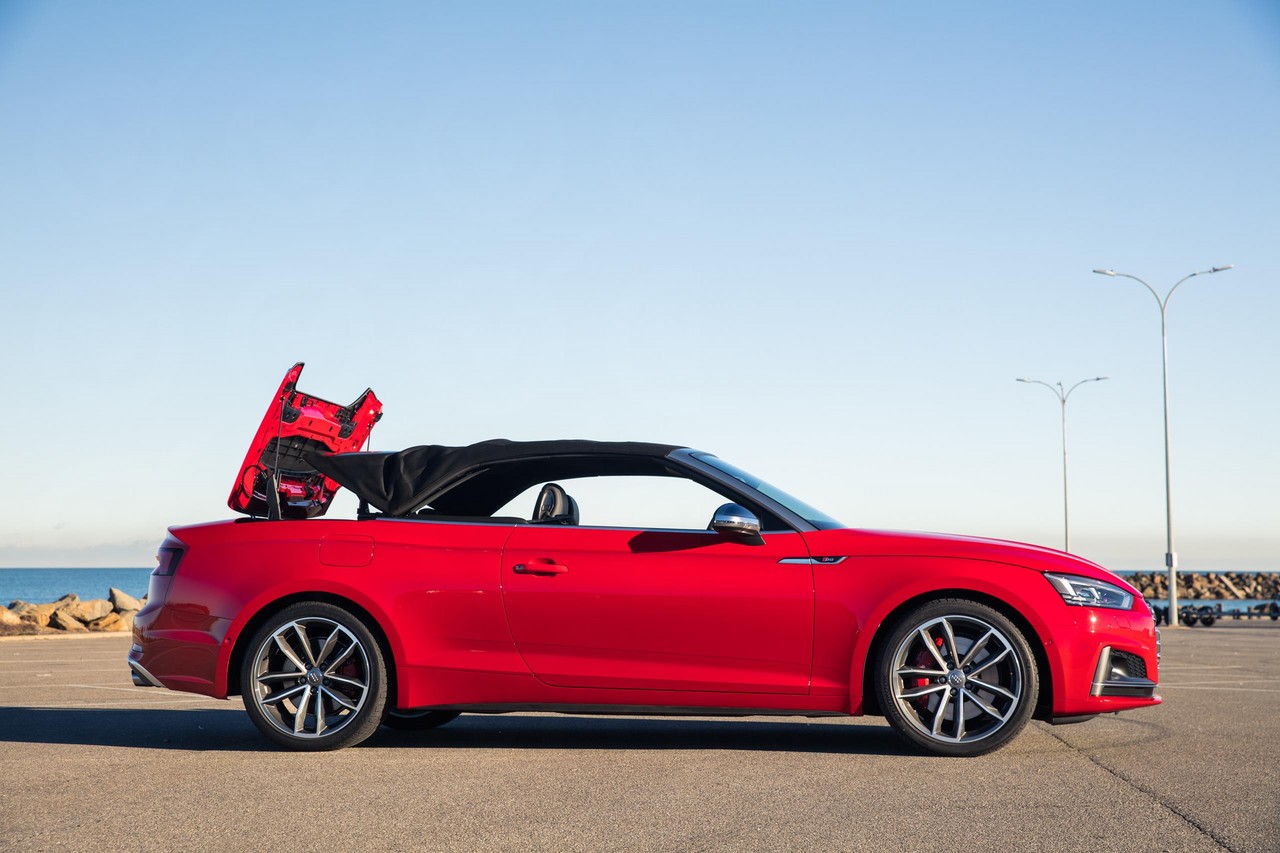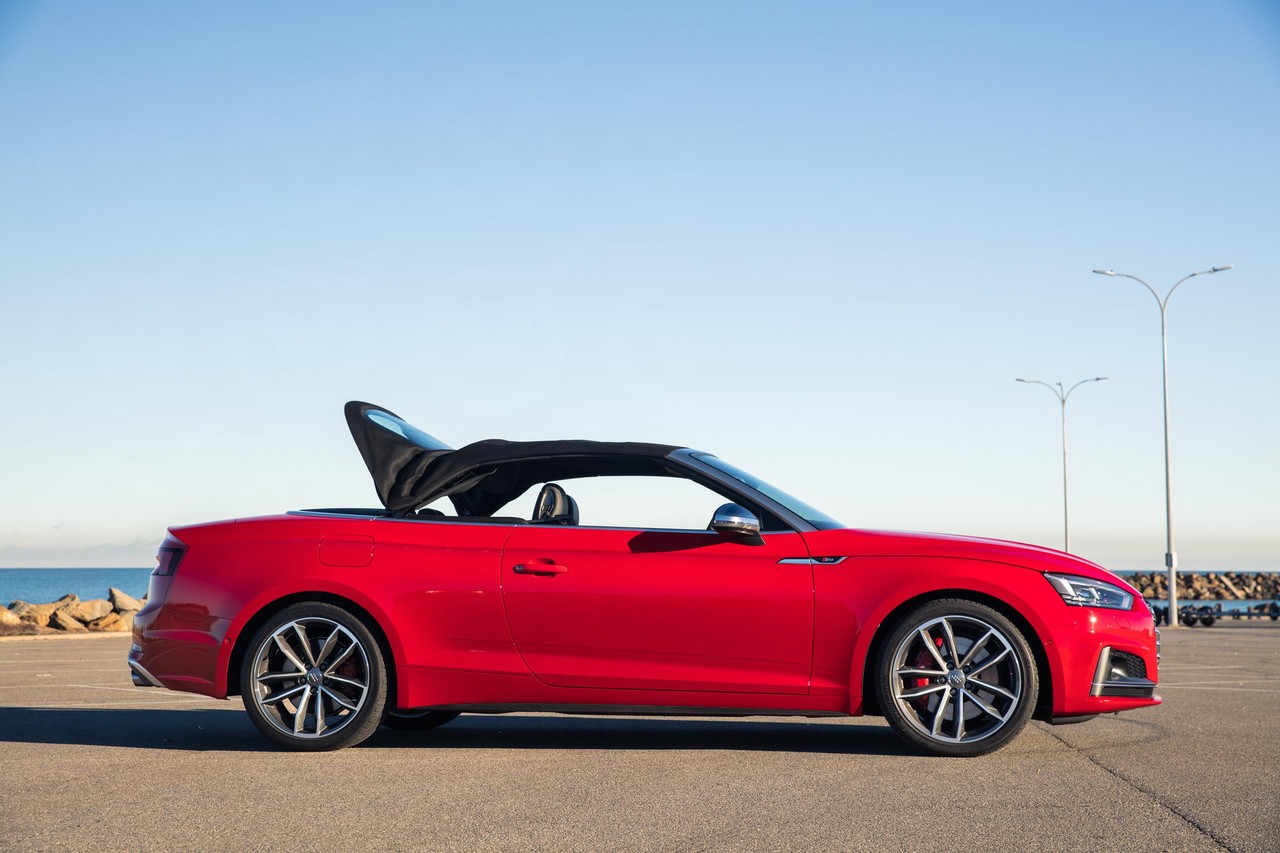
- Powerful 3.0-litre turbo V6 engine
- quattro all-wheel drive traction
- Comfortable and supportive seats
- Accurate steering
- Suspension compliance?
- Familiar styling
- Lost between the A5 and likely RS 5 Cabriolets
Overview
Released in Australia in September 2017, the Audi F5 S5 Cabriolet was a four-seat convertible with a soft-top roof. Manufactured in Ingolstadt, Germany, the all-wheel drive Audi S5 Cabriolet was powered by a 3.0-litre turbocharged V6 petrol engine – like the Audi F5 S5 Coupe – that was mated to an eight-speed automatic transmission. To reduce fuel consumption,
- The engine had a Start-Stop function which enabled it to shut down as the vehicle was coming to rest – this occurred at speeds of 7 km/h and below; and,
- A free-wheel function which disengaged the engine from the driveline at speeds between 55 km/h and 160 km/h to reduce engine braking.
The Audi S5 Cabriolet could accelerate from rest to 100 km/h in 5.1 seconds and had an electronically-limited top speed of 250 km/h.
| Engine | Trans. | Peak power | Peak torque | |
|---|---|---|---|---|
| Audi F5 S5 Cabriolet | 2995 cc turbo petrol V6 | 8sp auto | 260 kW at 5400-6400 rpm | 500 Nm at 1370-4500 rpm |
quattro all-wheel drive system
The four-wheel drive ‘quattro’ system for the Audi F5 S5 Cabriolet was a purely mechanical system which utilised a self-locking central differential (designed as a planetary gear train). In normal conditions, the differential provided 60 per cent of the engine’s torque to the rear axle and 40 per cent to the front, i.e. a 40:60 front:rear torque split. Depending on the situation, however, up to 70 per cent of the engine’s torque could be transferred to the front and up to 85 per cent to the rear.
As an extra-cost option ($2950 at launch), the S5 Cabriolet could be specified with a ‘sport differential’ that distributed torque between the rear wheels via two superposition gears. In this process, a software function integrated into the central chassis control unit continuously computed the ideal torque split. When turning into or accelerating in a curve, most of the torque would therefore be directed to the outside wheel to generate yaw and reduce understeer.
Wheel-selective torque control
As standard, the Audi S5 Cabriolet has ‘wheel-selective torque control’. During ‘dynamic cornering’, wheel-selective torque control brakes the front inner wheel (for front-wheel drive models) or front and rear inside wheels (for quattro models) to prevent wheelspin and improve turn-in.
Body and dimensions
The Audi F5 S5 Cabriolet is underpinned by Volkswagen’s MQB platform and, relative to the Audi F5 S5 Coupe , had additional struts in the body and reinforced sills. Compared to the Audi 8F7 S5 Cabriolet , the F5 S5 Cabriolet was 57 mm longer (at 4692 mm), 10 mm narrower (1846 mm), 2 mm taller (1382 mm) and had a 14 mm longer wheelbase (2765 mm). The Audi F5 S5 Cabriolet had a dry weight of 1690 kg (excludes driver and fluids).
The body of the Audi F5 S5 Cabriolet used hot-formed steels to re-inforce the steel in the side sills, the A-pillars and B-pillars; by weight, hot-formed steels comprised 17 per cent of the body structure. Other attributes of the F5 S5 Cabriolet body included:
- A higher sill cross-section;
- Closed ring structures in the area of the rear panel and rear end;
- More effective integration of diagonal struts into the load paths of the body structure; and,
- Highly integrated cast aluminium parts for the front strut domes.
Although Audi did not provide an actual measure of torsional rigidity, Audi claimed class-leading stiffness that exceeded its predecessor by 40 per cent, while achieving an overall mass reduction of around 40 kg. The Audi F5 S5 Cabriolet had a boot capacity of 380 litres with its roof closed, though this decreased to 320 litres when the roof was open.
The Audi F5 S5 Cabriolet had a power-operated soft-top roof that could open in 15 seconds and close in 18 seconds. Furthermore, the roof could be operated while the S5 Cabriolet was being driven at speeds of up to 50 km/h.
Suspension
The Audi F5 S5 Cabriolet had five-link front suspension in which the upper links were integrated into the bodywork and the lower links were attached with rubber mounts to a hybrid steel/aluminium sub-frame. For the five-link rear suspension, the axle was insulated from the body by hydraulically damped axle mounts. To reduce mass, the axle links, pivot bearings and damper stilts were made of forged aluminium.
As standard, the Audi S5 Cabriolet had ‘Continuous Damping Control’ (CDC) shock absorbers which had electromagnetically controlled valves in their pistons to control the flow of hydraulic fluid. For the CDC system, the central suspension control unit processed inputs from sensors that measured movement and acceleration (longitudinal and transverse) to control each shock absorber individually. Furthermore, the ‘Audi drive select driving-dynamics’ system enabled the driver to select from ‘sports’ or ‘comfort’ settings.
Steering
The Audi F5 S5 Cabriolet had electromechanical power steering in which the level of power assistance was inversely proportional to vehicle speed. As an option, the F5 S5 Cabriolet was available with ‘dynamic steering’ which varies its ratio – by up to 100 per cent – according to the vehicle speed, steering angle and the mode selected in the ‘Audi drive select driving-dynamics’ system.
Safety equipment
Standard safety equipment for the Audi F5 S5 Cabriolet included dual front airbags, combined head/thorax side airbags for front occupants, ABS, electronic brake force distribution, brake assist, electronic stability control, traction control and front seatbelts with pre-tensioners and load limiters.
As standard, the Audi F5 S5 Cabriolet was equipped with the following active safety technologies –
- Audi pre sense city: operating at speeds up to 85 km/h, Audi pre sense city used a windscreen-mounted front camera to scan the road for other vehicles and pedestrians. If there was a collision risk, the driver would receive a series of warnings. If the driver failed to respond, full braking force could be applied autonomously. From initial speeds of up to 40 km/h, collisions could be prevented; at higher speeds (up to 85 km/h), the severity of the collision was reduced;
- Audi pre sense basic: initiated occupant protection measures such as tightening the front seatbelts, closing the windows and activating the hazard lights when ‘unstable driving conditions’ were detected or a collision was anticipated;
- Audi pre sense rear: could warn of potential collisions from behind, alert following traffic by rapidly flashing the brake lights and activate the ‘Audi pre sense basic’ protection measures described above;
- Audi side assist: operating at speeds above 15 km/h, Audi side assist used two rear radar sensors to monitor traffic up to 70 metres behind the S5 Cabriolet. If another vehicle was approaching quickly or was in the driver’s blind spot, a warning LED in the housing of the appropriate door mirror would illuminate. If the driver activated the indicator to change lanes, the LED would blink rapidly to warn the driver;
- Rear cross-traffic assist: when reversing at low speeds, rear cross-traffic assist used the rear radar sensors to detect approaching traffic. If approaching traffic was detected which may cross the vehicle’s path, the driver would receive warnings (visual and acoustic) and be alerted by a brief, jolting application of the brakes;
- Exit warning: activated when the vehicle stopped moving, exit warning would alert occupants if vehicles were approaching from behind by illuminating red fibre optics in the door-opening mechanism as the doors were opened;
- Multi-collision brake: in the event of a collision, the multi-collision brake function provided ‘controlled application of the brakes’ to prevent the car from skidding and to reduce the risk and severity of secondary collisions; and,
- Attention assist: monitored driver behaviour and issued a warning if the driver was assessed to be ‘inattentive’.
Assistance Package Tour
Although optional on the Audi F5 A5 Cabriolet , the Audi F5 S5 Cabriolet was fitted with Audi’s ‘Assistance package tour’ which included –
- Adaptive Cruise Control (ACC): using two front radar sensors and the camera, ACC could maintain a specified distance – from five selectable distances – between the S5 Cabriolet and the vehicle ahead at speeds up to 250 km/h. Furthermore, ‘Audi drive select’ could be used to adjust the rate of acceleration and other control dynamics;
- Stop&Go function: an extension of the ACC and limited to models with automatic or double clutch transmissions, ‘Stop&Go’ operated at speeds of up to 60 km/h and could apply the brakes to bring the vehicle to rest. Once traffic began moving, the Audi S5 Cabriolet would automatically accelerate;
- Traffic-jam assist: an extension of the ACC, the traffic-jam assist function could take control of steering operations at speeds up to 65 km/h on ‘well-developed roads when traffic is congested.’ To do so, traffic-jam assist used lane markings and other vehicles on the road for orientation. When the traffic-jam assist function reached its limits – for example, when traffic was sparse or there was a sharp corner ahead – the driver had to take over steering. Hence, the system provided warnings at different levels;
- Audi pre-sense front: could prevent front-to-rear collisions or reduce their severity. In hazardous situations, the driver received visual and acoustic warnings to apply the brakes, followed by a brief application of the brakes for a jolting effect to alert the driver;
- Audi active lane assist: used the front camera to detect lane markings at speeds of 65 km/h and above. If the Audi S5 Cabriolet approached a lane marking without the driver having previously indicated, the electromechanical steering could provide an adjustment to bring the vehicle back into its lane. Using the MMI system, the driver could determine whether this system should be activated at all times or only before the lane marking was crossed. As an option, the driver could choose to have steering wheel vibrations as a warning signal;
- Collision avoidance assist: activated when the S5 Cabriolet needed to avoid an obstacle to avert a collision. Using data from the front camera, the ACC and radar sensors, ‘avoidance assist’ could calculate the distance of the car ahead, its width and degree of offset. The brakes would be briefly applied to alert the driver of the potential danger and, once the driver started steering, the system would provide ‘support with the necessary lane changes with controlled interventions to the power steering’;
- Turning assist: active at speeds from 2 km/h to 10 km/h, ‘Turning assist’ could monitor oncoming traffic during right turns (for cars with right-hand drive). In hazardous situations, the brakes could be applied automatically to bring the vehicle to rest. Turning assist commenced operation when the driver activated the right-hand turn signal; and,
- High beam assist: automatically switched between low and high beam headlights to improve visibility and avoid dazzling other drivers, using a sensor to determine when it was safe to do so.
Features: Audi F5 S5 Cabriolet 3.0 TFSI quattro
The standard infotainment system for the Audi F5 S5 Cabriolet consisted of a 180 watt Audi sound system with a six-channel amplifier and ten loudspeakers, a digital radio tuner (DAB+), Audi smartphone interface for Apple or Android OS smartphone integration, ‘Audi connect’ Wi-Fi hotspot, Audi music interface with two USB inputs and auxiliary (3.5 mm) input socket, and Bluetooth interface with audio streaming. Furthermore, the ‘MMI navigation plus’ system consisted of a satellite navigation system with an 8.3-inch high resolution display and 3D maps, three years of map updates, integrated voice control with natural language voice input, MMI touch control panel with handwriting recognition, live traffic updates, MMI radio and DVD/CD player, 2 SDXC card readers and a 10 GB flash memory for media storage.
Beyond this, standard features for the Audi F5 S5 Cabriolet included 19-inch alloy wheels with 255/35 R19 tyres, power adjustable ‘S’ front sport seats (with integrated head restraints, manually extendable thigh support, massage function and pneumatic bolster adjustment), heated seats (front and rear), Fine Nappa leather upholstery with diamond pattern stitching, three-zone climate control air conditioning, LED headlights, LED daytime running lights, LED tail-lights with dynamic indicators, a flat-bottomed leather steering wheel with gearshift paddles, 50:50 split and folding rear seats, remote central locking with proximity key, power adjustable and heated door mirrors with auto-dimming and folding functions, kerb view function for the passenger side door mirror, power windows, tilt and telescopic steering wheel adjustment, an auto-dimming rear view mirror, driver memory settings for the seat and door mirrors, push-button start, ‘carbon atlas’ interior inlays, ambient interior lighting with thirty selectable colours, a manually installable wind deflector, a tyre pressure loss indicator, a trip computer and an immobiliser.
As standard, the A5 Cabriolet was equipped with the ‘Audi parking system plus’ which included a rear view camera and parking sensors (front and rear), and the ‘Audi virtual cockpit’ which consisted of a 12.3-inch display (1440 x 540 pixels) for the instrument panel. The S5 Cabriolet was also equipped with a ‘Parking assistance’ package which consisted of:
- Consisted of four wide-angle cameras which provided a 360 degree surround view of the vehicle; and,
- Audi’s ‘Park assist’ which could detect parking spaces and provide automated steering for parallel or perpendicular parking manoeuvres while the driver controlled vehicle speed.
Specifications
